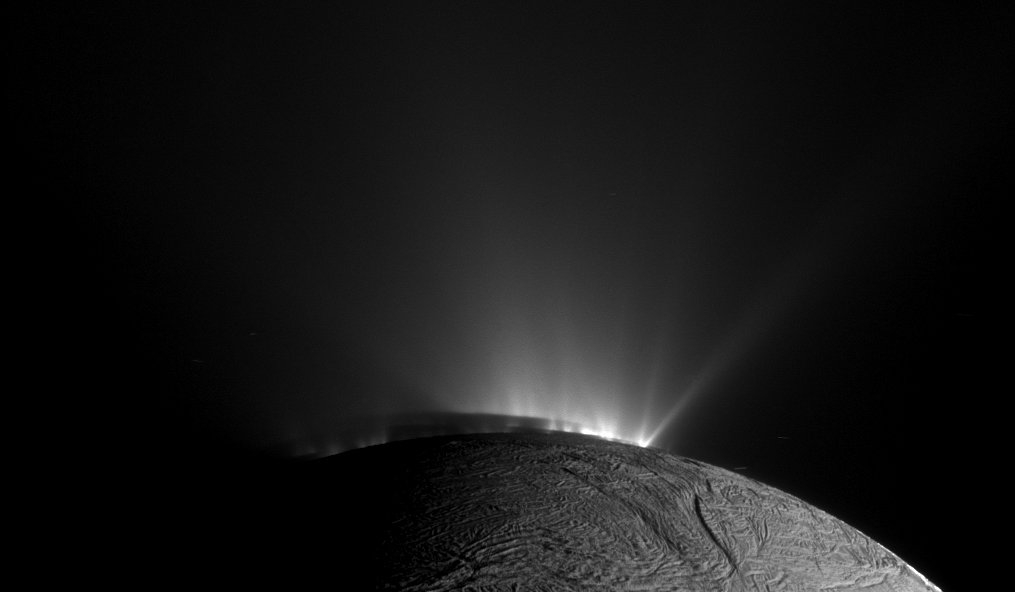200 AMU macromolecular organics detected in plumes on Enceladus
Cassini was intentionally crashed into the atmosphere of Saturn late in 2016, to avoid contamination of any of the moons of the planet. While that ended data collection from Saturn and its moons, data analysis continues to produce surprises. Saturn’s moon Enceladus harbours a global ocean beneath an icy crust and above a rocky core.

A surprising discovery in 2005 which initiated widespread debate on the potential of Enceladus to harbour life was the observation of active cryo-volcanic plumes ejecting ice and vapour into space. It was conjectured that hydrothermal activity in the core of the moon was powered by tidal dissipation produced by the strong gravitational field of Saturn. Studies of the plume in a close fly-by by Cassini revealed the present of simple organic molecules mostly below 50 Atomic Mass Units (AMUs). In a new study just published in Nature, Frank Postberg et al report the observation of emitted ice grains containing organic material with molecular mass above 200 AMU, complex macromolecular organic matter.
Plumes From Saturn’s Moon Enceladus Hint That It Could Support Life. Source: CreditNASA/JPL-Caltech, via Space Science Institute
Two mass spectrometers onboard Cassini, the Cosmic Dust Analyser and the Ion and Neutral Mass Spectrometer performed compositional in-situ measurements of material emerging from the surface of Enceladus, both within the plume and Saturn’s E-ring. the E-ring has been formed by ice grains escaping the moon’s gravity.
The organic fragments, of up to 200 units of molecular mass, are created as the ice grains hit the dust-analysing instrument on Cassini at speeds of about 30 000 kilometres per hour, but the researchers believe that, prior to the collision, the grains contain the original, even larger molecules, which could have molecular weights of thousands of atomic mass units.
Scientists calculate molecular mass, or weight, as the sum of weights of individual atoms contained in the molecule. Previously, Cassini had only detected lightweight organic molecules at Enceladus that were much smaller than the most recently found fragments.
Such large molecules can only be created by complex chemical processes – including those related to life. Alternatively, they could come from primordial material as found in some meteorites or, more likely, be generated by hydrothermal activity.
The authors suggest the presence of a refractory organic rich film at the top of the oceanic water table as the most plausible way to generate the observed grains. They suggest that this insoluble organic layer would exist at the top of the water layer likely at the base and within the large cracks evident on the surface of the moon.
This discovery is the first ever detection of complex organics on an extraterrestrial body. In an European space Agency press release, Frank Postberg commented:
“It is the first ever detection of complex organics coming from an extraterrestrial water-world. We found large molecular fragments that show structures typical for very complex organic molecules. These huge molecules contain a complex network often built from hundreds of atoms of carbon, hydrogen, oxygen and likely nitrogen that form ring-shaped and chain-like substructures.”
“In my opinion the fragments we found are of hydrothermal origin, having been processed inside the hydrothermally active core of Enceladus: in the high pressures and warm temperatures we expect there, it is possible that complex organic molecules can arise,” says Frank.
Be very happy – it happened in your lifetime.
Macromolecular organic compounds from the depths of Enceladus
Frank Postberg, Nozair Khawaja, Bernd Abel, Gael Choblet, Christopher R. Glein, Murthy S. Gudipati, Bryana L. Henderson, Hsiang-Wen Hsu, Sascha Kempf, Fabian Klenner, Georg Moragas-Klostermeyer, Brian Magee, Lenz Nölle, Mark Perry, René Reviol, Jürgen Schmidt, Ralf Srama, Ferdinand Stolz, Gabriel Tobie, Mario Trieloff & J. Hunter Waite
Abstract
Saturn’s moon Enceladus harbours a global water ocean1, which lies under an ice crust and above a rocky core2. Through warm cracks in the crust3 a cryo-volcanic plume ejects ice grains and vapour into space4,5,6,7 that contain materials originating from the ocean8,9. Hydrothermal activity is suspected to occur deep inside the porous core10,11,12, powered by tidal dissipation13. So far, only simple organic compounds with molecular masses mostly below 50 atomic mass units have been observed in plume material6,14,15. Here we report observations of emitted ice grains containing concentrated and complex macromolecular organic material with molecular masses above 200 atomic mass units. The data constrain the macromolecular structure of organics detected in the ice grains and suggest the presence of a thin organic-rich film on top of the oceanic water table, where organic nucleation cores generated by the bursting of bubbles allow the probing of Enceladus’ organic inventory in enhanced concentrations.
